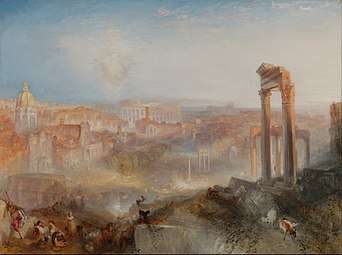J. M. W. Turner
| J. M. W. Turner RA | |
|---|---|
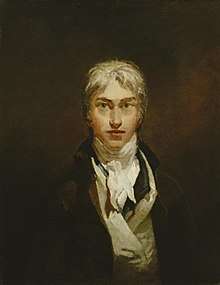 Self-portrait, oil on canvas, c. 1799 | |
| Born |
Joseph Mallord William Turner 23 April 1775 Covent Garden, London, England |
| Died |
19 December 1851 (aged 76) Cheyne Walk, Chelsea, England |
| Nationality | English |
| Education | Royal Academy of Arts |
| Known for | Paintings |
| Movement | Romanticism |
Joseph Mallord William Turner RA (23 April 1775 – 19 December 1851), known as J. M. W. Turner and contemporarily as William Turner,[a] was an English Romantic painter, printmaker and watercolourist, known for his expressive colourisation, imaginative landscapes and turbulent, often violent marine paintings. Turner was born in Maiden Lane, Covent Garden, London, to a modest lower middle-class family. He lived in London all his life, retaining his Cockney accent and assiduously avoiding the trappings of success and fame. A child prodigy, Turner studied at the Royal Academy of Arts from 1789, enrolling when he was 14, and exhibited his first work there at 21. During this period, he also served as an architectural draftsman. He earned a steady income from commissions and sales, which due to his troubled, contrary nature, were often begrudgingly accepted. He opened his own gallery in 1804 and became professor of perspective at the Academy in 1807, where he lectured until 1828, although he was viewed as profoundly inarticulate. He traveled to Europe from 1802, typically returning with voluminous sketchbooks.
Intensely private, eccentric and reclusive, Turner was a controversial figure throughout his career. He did not marry, but fathered two daughters, Eveline (1801–1874) and Georgiana (1811–1843), by his housekeeper Sarah Danby. He became more pessimistic and morose as he got older, especially after the death of his father, after which his outlook deteriorated, and his gallery fell into disrepair and neglect, and his art intensified. He lived in near poverty circumstances and in poor health from 1845, and died in London in 1851 aged seventy-six. Turner is buried in Saint Paul's Cathedral, London.
He left behind over 2,000 paintings and 19,000 drawings and sketches. He had been championed by the leading English art critic John Ruskin from 1840, and is today regarded as having elevated landscape painting to an eminence rivaling history painting.[1]
Biography
Early life
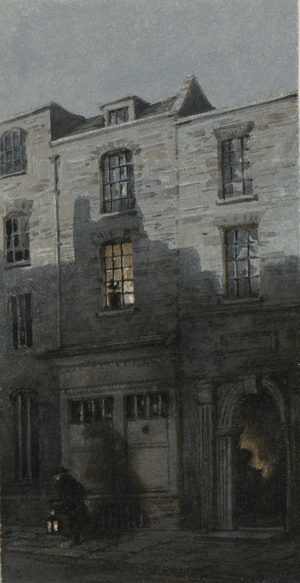
Joseph Mallord William Turner was born on 23 April 1775 and baptised on 14 May.[c] He was born in Maiden Lane, Covent Garden, in London, England.[2] His father, William Turner (1745–21 September 1829), was a barber and wig maker.[3] His mother, Mary Marshall, came from a family of butchers.[4] A younger sister, Mary Ann, was born in September 1778 but died in August 1783.[5]
Turner's mother showed signs of mental disturbance from 1785 and was admitted to St Luke's Hospital for Lunatics in Old Street in 1799 and was moved in 1800 to Bethlem Hospital[6] where she died in 1804. Turner was sent to his maternal uncle, Joseph Mallord William Marshall, in Brentford, then a small town on the banks of the River Thames west of London. The earliest known artistic exercise by Turner is from this period—a series of simple colourings of engraved plates from Henry Boswell's Picturesque View of the Antiquities of England and Wales.[7] Around 1786, Turner was sent to Margate on the north-east Kent coast. There he produced a series of drawings of the town and surrounding area that foreshadowed his later work.[8] By this time, Turner's drawings were being exhibited in his father's shop window and sold for a few shillings.[4] His father boasted to the artist Thomas Stothard that: "My son, sir, is going to be a painter".[9] In 1789, Turner again stayed with his uncle who had retired to Sunningwell in Berkshire (now part of Oxfordshire). A whole sketchbook of work from this time in Berkshire survives as well as a watercolour of Oxford. The use of pencil sketches on location, as the foundation for later finished paintings, formed the basis of Turner's essential working style for his whole career.[7]
Many early sketches by Turner were architectural studies or exercises in perspective, and it is known that, as a young man, he worked for several architects including Thomas Hardwick, James Wyatt and Joseph Bonomi the Elder.[10] By the end of 1789, he had also begun to study under the topographical draughtsman Thomas Malton, specialised in London views. Turner learned from him the basic tricks of the trade, copying and colouring outline prints of British castles and abbeys. He would later call Malton "My real master".[11] Topography was a thriving industry by which a young artist could pay for his studies.
Royal Academy
Turner entered the Royal Academy of Art in 1789, aged 14,[12] and was accepted into the academy a year later by Sir Joshua Reynolds. Turner showed an early interest in architecture, but was advised by Thomas Hardwick to focus on painting. His first watercolour, A View of the Archbishop's Palace, Lambeth was accepted for the Royal Academy summer exhibition of 1790 when Turner was 15.
As an academy probationer, Turner was taught drawing from plaster casts of antique sculptures. From July 1790 to October 1793, his name appears in the registry of the academy over a hundred times.[13] In June 1792, he was admitted to the life class to learn to draw the human body from nude models.[14] Turner exhibited watercolours each year at the academy while painting in the winter and travelling in the summer widely throughout Britain, particularly to Wales, where he produced a wide range of sketches for working up into studies and watercolours. These particularly focused on architectural work, which used his skills as a draughtsman.[13] In 1793, he showed the watercolour titled The Rising Squall – Hot Wells from St Vincent's Rock Bristol (now lost), which foreshadowed his later climatic effects.[15] Cunningham in his obituary of Turner wrote that it was: "recognised by the wiser few as a noble attempt at lifting landscape art out of the tame insipidities...[and] evinced for the first time that mastery of effect for which he is now justly celebrated".[16]
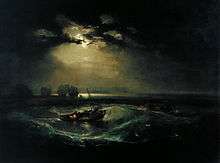
In 1796, Turner exhibited Fishermen at Sea, his first oil painting for the academy, of a nocturnal moonlit scene of the Needles off the Isle of Wight, an image of boats in peril.[17] Wilton said that the image: "Is a summary of all that had been said about the sea by the artists of the 18th century".[18] and shows strong influence by artists such as Claude Joseph Vernet, Philip James de Loutherbourg, Peter Monamy and Francis Swaine, who was admired for his moonlight marine paintings. This particular painting cannot be said to show any influence of Willem van de Velde the Younger, as not a single nocturnal scene is known by that painter. Some later work, however, was created to rival or complement the manner of the Dutch artist. The image was praised by contemporary critics and founded Turner's reputation, as both an oil painter and a painter of maritime scenes.[19]
Early career
.jpg)
Turner travelled widely in Europe, starting with France and Switzerland in 1802 and studying in the Louvre in Paris in the same year. He made many visits to Venice. Important support for his work came from Walter Ramsden Fawkes of Farnley Hall, near Otley in Yorkshire, who became a close friend of the artist. Turner first visited Otley in 1797, aged 22, when commissioned to paint watercolours of the area. He was so attracted to Otley and the surrounding area that he returned to it throughout his career. The stormy backdrop of Hannibal Crossing The Alps is reputed to have been inspired by a storm over the Chevin in Otley while he was staying at Farnley Hall.
Turner was a frequent guest of George O'Brien Wyndham, 3rd Earl of Egremont, at Petworth House in West Sussex and painted scenes that Egremont funded taken from the grounds of the house and of the Sussex countryside, including a view of the Chichester Canal. Petworth House still displays a number of paintings.
Personal life
As Turner grew older, he became more eccentric. He had few close friends except for his father, who lived with him for 30 years and worked as his studio assistant. His father's death in 1829 had a profound effect on him, and thereafter he was subject to bouts of depression. He never married but had a relationship with an older widow, Sarah Danby. He is believed to have been the father of her two daughters born in 1801 and 1811.[20]
Turner formed a relationship with Sophia Caroline Booth after her second husband died, and he lived for about 18 years as "Mr Booth" in her house in Chelsea.[21]
Turner was a habitual user of snuff; in 1838, Louis Philippe I, King of the French presented a gold snuff box to him.[22] Of two other snuffboxes, an agate and silver example bears Turner's name,[23] and another, made of wood, was collected along with his spectacles, magnifying glass and card case by an associate housekeeper.[24]
Death
Turner died of cholera at the home of Sophia Caroline Booth, in Cheyne Walk in Chelsea, on 19 December 1851. He is buried in St Paul's Cathedral, where he lies near to Sir Joshua Reynolds.[25] Apparently his last words were "The Sun is God",[26] though this may be apocryphal.[27]
Turner's friend, the architect Philip Hardwick (1792–1870), son of his tutor, Thomas Hardwick, was in charge of making the funeral arrangements and wrote to those who knew Turner to tell them at the time of his death that, "I must inform you, we have lost him." Other executors were his cousin and chief mourner at the funeral, Henry Harpur IV (benefactor of Westminster – now Chelsea & Westminster – Hospital), Revd. Henry Scott Trimmer, George Jones RA and Charles Turner ARA.[28]
Art
Style
Turner's talent was recognised early in his life. Financial independence allowed Turner to innovate freely; his mature work is characterised by a chromatic palette and broadly applied atmospheric washes of paint. According to David Piper's The Illustrated History of Art, his later pictures were called "fantastic puzzles". Turner was recognised as an artistic genius: the influential English art critic John Ruskin described him as the artist who could most "stirringly and truthfully measure the moods of Nature".[29] Turner's work drew criticism from contemporaries, in particular from Sir George Beaumont, a landscape painter and fellow member of the Royal Academy, who described his paintings as 'blots'.[30]
Turner's imagination was sparked by shipwrecks, fires (including the burning of Parliament in 1834, an event which Turner witnessed first-hand, and transcribed in a series of watercolour sketches), and natural phenomena such as sunlight, storm, rain, and fog. He was fascinated by the violent power of the sea, as seen in Dawn after the Wreck (1840) and The Slave Ship (1840).
 For his painting Turner drew inspiration from the art of Willem van de Velde the Younger
For his painting Turner drew inspiration from the art of Willem van de Velde the Younger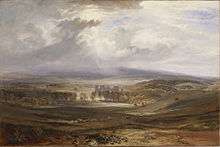 One of Turner's most successful "house portraits": Raby Castle, the Seat of the Earl of Darlington.[31] The Walters Art Museum, Baltimore
One of Turner's most successful "house portraits": Raby Castle, the Seat of the Earl of Darlington.[31] The Walters Art Museum, Baltimore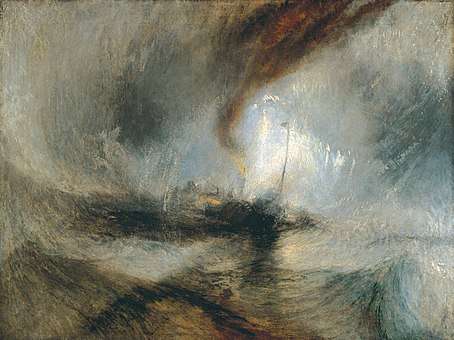
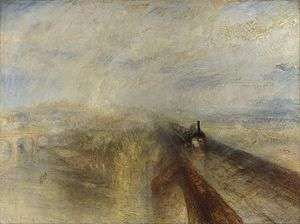
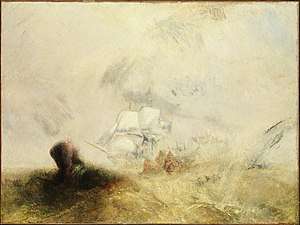 Whalers, 1845, Metropolitan Museum of Art
Whalers, 1845, Metropolitan Museum of Art
Turner's major venture into printmaking was the Liber Studiorum (Book of Studies), seventy prints that he worked on from 1806 to 1819. The Liber Studiorum was an expression of his intentions for landscape art. The idea was loosely based on Claude Lorrain's Liber Veritatis (Book of Truth), where Lorrain had recorded his completed paintings; a series of print copies of these drawings, by then at Devonshire House, had been a huge publishing success. Turner's plates were meant to be widely disseminated, and categorised the genre into six types: Marine, Mountainous, Pastoral, Historical, Architectural, and Elevated or Epic Pastoral.[32] His printmaking was a major part of his output, and a museum is devoted to it, the Turner Museum in Sarasota, Florida, founded in 1974 by Douglass Montrose-Graem to house his collection of Turner prints.[33]
Turner's early works, such as Tintern Abbey (1795), stayed true to the traditions of English landscape. However, in Hannibal Crossing the Alps (1812), an emphasis on the destructive power of nature had already come into play. His distinctive style of painting, in which he used watercolour technique with oil paints, created lightness, fluency, and ephemeral atmospheric effects.[34]
In Turner's later years he used oils ever more transparently and turned to an evocation of almost pure light by use of shimmering colour. A prime example of his mature style can be seen in Rain, Steam and Speed – The Great Western Railway, where the objects are barely recognisable. The intensity of hue and interest in evanescent light not only placed Turner's work in the vanguard of English painting but exerted an influence on art in France; the Impressionists, particularly Claude Monet, carefully studied his techniques.
High levels of volcanic ash (from the eruption of Mt. Tambora) in the atmosphere during 1816, the "Year Without a Summer", led to unusually spectacular sunsets during this period, and were an inspiration for some of Turner's work.
John Ruskin said that an early patron, Thomas Monro, Principal Physician of Bedlam, and a collector and amateur artist, was a significant influence on Turner's style:
His true master was Dr Monro; to the practical teaching of that first patron and the wise simplicity of method of watercolour study, in which he was disciplined by him and companioned by his friend Girtin, the healthy and constant development of the greater power is primarily to be attributed; the greatness of the power itself, it is impossible to over-estimate.
Together with a number of young artists, Turner was able, in the London house of Dr. Monro, to copy works of the major topographical draughtsmen of his time and perfect his skills in drawing. But the curious atmospherical effects and illusions of the watercolours of John Robert Cozens, some of which were present in Monro's house, went far further than the neat renderings of topography. The solemn grandeur of his Alpine views were an early revelation to the young artist and showed him the true potential of the watercolour medium, conveying mood instead of information.
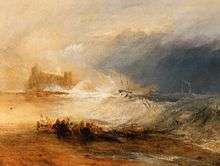 Wreckers Coast of Northumberland, painted ca. 1836. Yale Center for British Art
Wreckers Coast of Northumberland, painted ca. 1836. Yale Center for British Art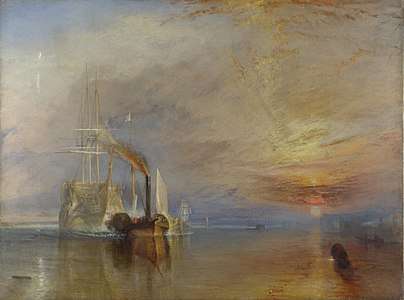 The Fighting Temeraire tugged to her last berth to be broken up, 1839
The Fighting Temeraire tugged to her last berth to be broken up, 1839 The Wreck of a Transport Ship (c. 1810), oil on canvas[35]
The Wreck of a Transport Ship (c. 1810), oil on canvas[35]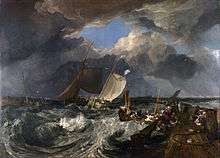 Calais Pier
Calais Pier
Materials
Turner experimented with a wide variety of pigment.[36] He used pigments like carmine, despite knowing that they were not long-lasting, and against the advice of contemporary experts to use more durable pigments. As a result, many of his colours have now faded. John Ruskin complained at how quickly his work decayed; Turner was indifferent to posterity and chose materials that looked good when freshly applied.[37] By 1930, there was concern that both his oils and his watercolours were fading.[38]
Legacy
Turner left a small fortune which he hoped would be used to support what he called "decayed artists". He planned an almshouse at Twickenham with a gallery for some of his works. His will was contested and in 1856, after a court battle, his first cousins, including Thomas Price Turner, received part of his fortune.[39] Another portion went to the Royal Academy of Arts, which occasionally awards students the Turner Medal. His finished paintings were bequeathed to the British nation, and he intended that a special gallery would be built to house them. This did not happen due to disagreement over the final site. Twenty-two years after his death, the British Parliament passed an act allowing his paintings to be lent to museums outside London, and so began the process of scattering the pictures which Turner had wanted to be kept together.
In 1910, the main part of the Turner Bequest, which includes unfinished paintings and drawings, was rehoused in the Duveen Turner Wing at the National Gallery of British Art (now Tate Britain). In 1987, a new wing at the Tate, the Clore Gallery, was opened to house the Turner bequest, though some of the most important paintings remain in the National Gallery in contravention of Turner's condition that they be kept and shown together. Increasingly paintings are lent abroad, ignoring Turner's provision that they remain constantly and permanently in Turner's Gallery.
St. Mary's Church, Battersea added a commemorative stained glass window for Turner, between 1976 and 1982.[40] St Paul's Cathedral, Royal Academy of Arts and Victoria & Albert Museum all hold statues representing him. A portrait by Cornelius Varley with his patent graphic telescope (Sheffield Museums & Galleries) was compared with his death mask (National Portrait Gallery, London) by Kelly Freeman at Dundee University 2009–10 to ascertain whether it really depicts Turner. The city of Westminster unveiled a memorial plaque at the site of his birthplace at 21 Maiden Lane, Covent Garden 2 June 1999.[41]
Selby Whittingham founded The Turner Society at London and Manchester in 1975. After the society endorsed the Tate Gallery's Clore Gallery wing (on the lines of the Duveen wing of 1910), as the solution to the controversy of what should be done with the Turner Bequest, Selby Whittingham resigned and founded the Independent Turner Society. The Tate created the prestigious annual Turner Prize art award in 1984, named in Turner's honour, and 20 years later the Royal Institute of Painters in Water Colours founded the Winsor & Newton Turner Watercolour Award. A major exhibition, "Turner's Britain", with material (including The Fighting Temeraire) on loan from around the globe, was held at Birmingham Museum and Art Gallery from 7 November 2003 to 8 February 2004. In 2005, Turner's The Fighting Temeraire was voted Britain's "greatest painting" in a public poll organised by the BBC.[42]
Portrayal in theatre, television and film
Leo McKern played Turner in The Sun is God, a 1974 Thames Television production directed by Michael Darlow.[43] The programme was shown on 17 December 1974, during the Turner Bicentenary Exhibition in London.[44]
In January 2011 The Painter, a biographical play on his life by Rebecca Lenkiewicz, premiered at the Arcola Theatre in London.
British filmmaker Mike Leigh wrote and directed Mr. Turner, a biopic of Turner's later years, released in 2014. The film starred Timothy Spall as Turner, Dorothy Atkinson, Marion Bailey and Paul Jesson, and premiered in competition for the Palme d'Or at the 2014 Cannes Film Festival, with Spall taking the award for Best Actor.[45][46]
Selected works
Turner was an extremely prolific artist who left behind more than 550 oil paintings, 2,000 watercolours, and 30,000 paper works.[47] The Tate Gallery in London produces the most comprehensive and up to date catalogue of Turner works[48] held in both public and private collections worldwide.
- 1796: Fishermen at Sea, oil on canvas, 36 × 48 1⁄8 in., Tate Gallery, London
- 1803: Bonneville, Savoy, Dallas Museum of Art, oil on canvas 92 x 123 cm
- 1806: The Battle of Trafalgar, as Seen from the Mizen Starboard Shrouds of the Victory, oil on canvas: Tate Gallery, London
- 1809: The Trout Stream, oil on canvas, Taft Museum, Cincinnati
- 1812: Snow Storm: Hannibal and His Army Crossing the Alps, oil on canvas, Tate Gallery, London
- 1815: Dido Building Carthage, or, The Rise of the Carthaginian Empire, oil on canvas, National Gallery, London
- 1815: Crossing the Brook, oil on canvas, Tate Gallery, London
- 1817: Eruption of Vesuvius, watercolour, gum, and scraping out on paper, Yale Center for British Art, New Haven, Connecticut
- 1817: Raby Castle, the Seat of the Earl of Darlington, oil on canvas, Walters Art Museum, Baltimore
- 1818: Dort or Dordrecht: The Dort packet-boat from Rotterdam becalmed, oil on canvas, Yale Center for British Art, New Haven, Connecticut
- 1822: The Battle of Trafalgar, oil on canvas, National Maritime Museum, Greenwich, London
- 1826: Cologne: The Arrival of a Packet-Boat: Evening, oil and possibly watercolour on canvas (lined), Frick Collection, New York
- 1829: Ulysses Deriding Polyphemus, oil on canvas, National Gallery, London
- 1834: Venice: The Dogana and San Giorgio Maggiore, oil on canvas, National Gallery of Art, Washington, DC
- 1834: The Fountain of Indolence, oil on canvas, Beaverbrook Art Gallery, Fredericton
- 1835: The Burning of the Houses of Lords and Commons, oil on canvas, Philadelphia Museum of Art, Philadelphia
- 1835: The Burning of the Houses of Lords and Commons, oil on canvas, Cleveland Museum of Art, Cleveland
- 1835: The Grand Canal, Venice, oil on canvas, Metropolitan Museum of Art, New York
- 1835: The Piazzetta, Venice, Watercolour and bodycolour with pen and ink and scraping on paper, Scottish National Gallery, Edinburgh
- 1836: Juliet and Her Nurse. Oil on canvas. Exh. Royal Academy. 36 1⁄2 × 48 1⁄2 (92 × 123).
- 1836: Mercury and Argus. Oil on canvas. reworked 1840. National Gallery of Canada, Ottawa, purchased 1951 . no.5795 .
- 1838: The Fighting Temeraire Tugged to Her Last Berth to Be Broken up, oil on canvas, National Gallery, London
- 1839: Modern Rome – Campo Vaccino, oil on canvas, J. Paul Getty Museum
- 1839: Ancient Rome; Agrippina Landing with the Ashes of Germanicus, oil on canvas, Tate
- 1840: Slave Ship (Slavers Throwing Overboard the Dead and Dying, Typhoon Coming On), oil on canvas, Museum of Fine Arts, Boston
- 1840: Neapolitan Fisher Girls Surprised Bathing by Moonlight, oil on canvas, Huntington Library
- 1840 – Clouds and water, olieverf op doek – Museum De Fundatie, Zwolle
- 1842: The Blue Rigi, Sunrise, watercolour on paper, Tate Britain, London
- 1842: Peace – Burial at Sea, Tate Gallery, London, on loan to Art Gallery of Ontario, Toronto, Canada
- 1842: Snow Storm: Steam-Boat off a Harbour's Mouth
- 1842: War. The Exile and the Rock Limpet, Tate Gallery, London, on loan to Art Gallery of Ontario, Toronto, Canada
- 1843: Light and Colour (Goethe's Theory) – The Morning after the Deluge – Moses Writing the Book of Genesis, oil on canvas, Tate Gallery, London
- 1843: The Evening of the Deluge, oil on canvas, Tate Gallery, London
- 1844: Ostende, oil on canvas, Neue Pinakothek, München
- 1844: Approach to Venice, oil on canvas, National Gallery of Art, Washington, DC
- 1844: Rain, Steam and Speed – The Great Western Railway, oil on canvas, National Gallery, London
- c. 1845: Sunrise with Sea Monsters, oil on canvas, Tate Gallery, London
- c. 1840–1850: Europa and the Bull, oil on canvas, Taft Museum, Cincinnati
Notes
a. ^ Although Turner was known by his middle name, William, he is now generally referred to by his initials, in order to avoid confusion with another artist named William Turner.
b. ^ Turner claimed to have been born on 23 April 1775, which is both Saint George's Day and the supposed birthday of William Shakespeare, but this claim has never been verified.[2] The first verifiable date is that Turner was baptised on 14 May, and some authors doubt the 23 April date, on the grounds that high infant mortality rates would have meant that parents would usually baptise their children shortly after birth.[49]
c.^ Mary Marshall died in 1804, after having been committed in 1799 to St Luke's Hospital and then to the Bethlem Royal Hospital, a mental asylum. Her illness possibly due in part to the early death of Turner's younger sister. Hamilton suggests that this "fit of illness" may have been an early sign of her madness.
References
- ↑ Lacayo, Richard (11 October 2007). "The Sunshine Boy". Time.
At the turn of the 18th century, history painting was the highest purpose art could serve, and Turner would attempt those heights all his life. But his real achievement would be to make landscape the equal of history painting.
- 1 2 Shanes, Eric (2008). The life and masterworks of J.M.W. Turner (4th ed.). New York: Parkstone Press. ISBN 978-1-85995-681-6.
- ↑ Herrmann, Luke (October 2006). Joseph Mallord William Turner. Oxford Dictionary of National Biography. Oxford University Press.
- 1 2 Hamilton, James (2007). Turner. New York: Random House. Chapter 1. ISBN 978-0-8129-6791-3. (Subscription required (help)).
- ↑ Bailey, Anthony (1998). Standing in the sun: a life of J.M.W. Turner. London: Pimlico. p. 8. ISBN 0-7126-6604-4. (Subscription required (help)).
- ↑ Brown, David Blayney (December 2012). "Joseph Mallord William Turner 1775–1851". In Brown, David Blayney. J.M.W. Turner: Sketchbooks, Drawings and Watercolours. Tate Research Publications. ISBN 978-1-84976-386-8. Retrieved 10 March 2016.
- 1 2 Wilton, Andrew (2006). Turner in his time (New ed.). London: Thames & Hudson. p. 14. ISBN 978-0-500-23830-1.
- ↑ Wilton, Andrew (2006). Turner in his time (New ed.). London: Thames & Hudson. p. 15. ISBN 978-0-500-23830-1.
- ↑ Thornbury, George Walter (1862). The life of J.M.W. Turner. p. 8.
- ↑ Hamilton, James (1997). "1". Turner : a life. London: Sceptre. ISBN 0-340-62811-1.
- ↑ Thornbury, George Walter (1862). The life of J.M.W. Turner. p. 27.
- ↑ Finberg, A. J. (1961). The Life of J.M.W. Turner, R.A. Clarendon Press. p. 17.
- 1 2 Hamilton, James (2007). Turner. New York: Random House. Chapter 2. ISBN 978-0-8129-6791-3.
- ↑ Wilton, Andrew (2006). Turner in his time (New ed.). London: Thames & Hudson. p. 17. ISBN 978-0-500-23830-1.
- ↑ Wilton, Andrew (2006). Turner in his time (New ed.). London: Thames & Hudson. p. 20. ISBN 978-0-500-23830-1.
- ↑ Cunningham, Peter (27 December 1851). "Obituary of Turner". The Athenaeum. pp. 17–18.
- ↑ Butlin, Martin; Joll, Evelyn (1984). The paintings of J.M.W. Turner (Rev. ed.). New Haven: Yale University Press. ISBN 978-0-300-03276-5.
- ↑ Wilton, Andrew (2006). Turner in his time (New ed.). London: Thames & Hudson. p. 27. ISBN 978-0-500-23830-1.
- ↑ Wilton, Andrew (2006). Turner in his time (New ed.). London: Thames & Hudson. p. 28. ISBN 978-0-500-23830-1.
- ↑ Roberts, Miquette. "The Unknown Turner". Tate. Retrieved 14 July 2014.
- ↑ "Turner Biography & Chronology – The Turner Society" (PDF).
- ↑ "Collection Online: Snuff Box/box". British Museum.
- ↑ "Georgian Silver and Agate Pocket Snuff Box Inscribed 'Joseph Mallord William Turner' and the date '1785'". Finch & Co. Retrieved 3 September 2014.
- ↑ "Spectacles, glass, snuffbox and cardcase of Turner 1775–1851". Philip Mould & Company. Retrieved 3 September 2014.
- ↑ David Blayney Brown, ‘Joseph Mallord William Turner 1775–1851’, artist biography, December 2012, in David Blayney Brown (ed.), J.M.W. Turner: Sketchbooks, Drawings and Watercolours, Tate Research Publication, December 2012, https://www.tate.org.uk/art/research-publications/jmw-turner/joseph-mallord-william-turner-1775-1851-r1141041, accessed 18 December 2017.
- ↑ Davies, Norman (20 January 1998). Europe: A History. London: Pimlico. p. 687. ISBN 978-0-06-097468-8. Retrieved 3 September 2014. (Subscription required (help)).
- ↑ Wilton, Andrew (2006-11-06). Turner in his Time (01 ed.). London: Thames and Hudson Ltd. ISBN 9780500238301.
- ↑ Thornbury, Walter (1862). The Life of J. M. W. Turner, R. A.: Founded on Letters and Papers Furnished by His Friends and Fellow Academicians. Hurst and Blackett. p. 418. Retrieved 18 December 2017.
- ↑ (Piper 321)
- ↑ Wilkinson, Gerald (1974). The Sketches of Turner, R.A. London: Barrie & Jenkins.
- ↑ "Raby Castle, the Seat of the Earl of Darlington". Walters Art Museum.
- ↑ Imms, Matthew (December 2012). Brown, David Blayney, ed. "J.M.W. Turner: Sketchbooks, Drawings and Watercolours". Tate Gallery. Retrieved 3 September 2014.
- ↑ "The Turner Museum". The Turner Museum and Thomas Moran Galleries. Retrieved 30 August 2010.
- ↑ Piper 321
- ↑ Brown, David Blayney (1 January 2013). "Sea Pictures: Turner's Marine Sublime and a Sketchbook of c.1803–10".
- ↑ Townsend, Joyce H. (1993). "The Materials of J. M. W. Turner: Pigments". Studies in Conservation. 38 (4): 231–254. doi:10.2307/1506368. JSTOR 1506368.
- ↑ Finlay, Victoria (2004). Color: A Natural History of the Palette. Random House Trade Paperbacks. pp. 134–135. ISBN 0-8129-7142-6. (Subscription required (help)).
- ↑ "Colors That Fade: Turner's Masterpieces: Can his works be saved?". The Daily News. 9 January 1930. p. 2. Retrieved 18 May 2014.
- ↑ Monkhouse, William Cosmo (1879). The Great Artists: J.M.W. Turner R.A. New York: Scribner and Welford. p. 121. Retrieved 3 September 2014.
- ↑ "St. Mary's Church Parish website".
St Mary's Modern Stained Glass
- ↑ "Joseph Mallord William Turner". City of Westminster. Archived from the original on 3 December 2013. Retrieved 3 September 2014.
- ↑ "Turner wins 'great painting' vote". BBC News. 5 September 2005. Retrieved 3 September 2014.
- ↑ "The Sun Is God (1974)". British Film Institute. Retrieved 31 March 2015.
- ↑ Whaley, George (2009). Leo 'Rumpole' McKern: The Accidental Actor. UNSW Press. p. 181. ISBN 978-1-921410-89-5. Retrieved 31 March 2015.
- ↑ Child, Ben (23 October 2012). "Timothy Spall to play JMW Turner in Mike Leigh biopic". The Guardian. Retrieved 3 September 2014.
- ↑ "Mr. Turner". Film 4. Retrieved 3 September 2014.
- ↑ "Turner Society Homepage". Retrieved 27 November 2011.
- ↑ "Joseph Mallord William Turner". Tate. Retrieved 3 September 2014.
- ↑ Hamilton, James (2007). Turner (Random House Trade Paperback ed.). New York: Random House. p. 8. ISBN 978-0-8129-6791-3.
Sources
- Bailey, Anthony (1998). Standing in the sun: A Life of J. M. W. Turner. London: Pimlico. ISBN 0-7126-6604-4.
- Bockemühl, Michael (2006). J. M. W. Turner, 1775–1851: the world of light and colour (2nd ed.). Köln: Taschen. ISBN 3-8228-6325-4.
- Finberg, A. J. The Life of J. M. W. Turner, R.A. (Oxford: the University Press, 1939 and 1961)
- Hamilton, James (2007). Turner. New York: Random House. ISBN 978-0-8129-6791-3.
- Harrison, Colin. Turner's Oxford (Ashmolean Museum, Oxford, 2000)
- Hill, David. Turner and Leeds: Image of Industry (Jeremy Mills Publishing, 2008)
- Warburton, Stanley. Discovering Turner's Lakeland (Lytham St Annes, 2008)
- Whittingham, Selby. An Historical Account of the Will of J. M. W. Turner, R.A. (J. M. W. Turner, R.A., Publications, London, 1993-6)
- Wilton, Andrew (2006). Turner in His Time (Revised ed.). London: Thames & Hudson. ISBN 978-0-500-23830-1.
Further reading
- Ackroyd, Peter (2005). J. M. W. Turner. Ackroyd's Brief Lives (1st ed.). New York: Nan A. Talese. ISBN 0-385-50798-4.
- Barker, Elizabeth E. "Joseph Mallord William Turner (1775–1851)". Heilbrunn Timeline of Art History. The Metropolitan Museum of Art.
- Joll, Evelyn (ed.); Butlin, Martin, Herrmann, Luke (2001). The Oxford companion to J. M. W. Turner. Oxford: Oxford Univ. Press. ISBN 0-19-860025-9.
- Venning, Barry (2003). Turner (1st publ. ed.). Berlin: Phaidon Verlag GmbH. ISBN 0-7148-3988-4.
External links
| Wikimedia Commons has media related to J. M. W. Turner. |
| Wikiquote has quotations related to: J. M. W. Turner |
| Wikisource has the text of the 1911 Encyclopædia Britannica article Turner, Joseph Mallord William. |

- 400 paintings by or after J. M. W. Turner at the Art UK site
- The Turner Society
- Christie's Videos – Giudecca, La Donna della Salute and San Giorgio Joseph Mallord William Turner,RA
- Sotheby's Videos – The Temple Of Jupiter Panellenius Joseph Mallord William Turner,RA
- Sotheby's Videos – Modern Rome Campo Vaccino and The condition of Modern Rome, Campo Vaccino J. M. W. Turner, RA
- J.M.W. Turner exhibition catalogs
- Web site of the Tate Turner Collection, includes the "Turner Bequest" of over 300 Oil paintings and over 30,000 sketches. The catalogue holds records of over 40,000 works by Turner
- Works by J. M. W. Turner at Project Gutenberg
- Works by or about J. M. W. Turner at Internet Archive
